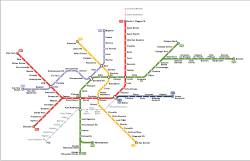You can help expand this article with text translated from the corresponding article in Italian. (June 2024) Click [show] for important translation instructions.
|
| Milan Metro | |||
|---|---|---|---|
 | |||
| Overview | |||
| Native name | Metropolitana di Milano | ||
| Locale | Milan, Lombardy, Italy | ||
| Transit type | Rapid transit | ||
| Number of lines | 5 | ||
| Number of stations | 125+2(in construction) | ||
| Daily ridership | 1.39 million (2018 average weekday)[1] 1.57 million (2018 peak)[1] | ||
| Annual ridership | 369 million (2018)[2] | ||
| Website | www | ||
| Operation | |||
| Began operation | 1 November 1964 | ||
| Operator(s) | Azienda Trasporti Milanesi | ||
| Number of vehicles | 225 (2023) | ||
| Technical | |||
| System length | 111.8 km (69.5 mi) | ||
| Track gauge | 1,435 mm (4 ft 8+1⁄2 in) standard gauge | ||
| Electrification | 750 V DC fourth rail (line 1) 1,500 V DC overhead catenary (lines 2 & 3) 750 V DC third rail (lines 4 & 5) | ||
| |||
The Milan Metro (Italian: Metropolitana di Milano) is the rapid transit system serving Milan, Italy, operated by Azienda Trasporti Milanesi. The network consists of 5 lines with a total network length of 111.8 kilometres (69.5 mi), and a total of 125 stations (+2 in construction), mostly underground. It has a daily ridership of about 1.4 million on weekdays. The Milan Metro is the largest rapid transit system in Italy in terms of length, number of stations and ridership; and the fifth longest in the European Union and the eighth in the Europe.[3]
The first line, Line 1, opened in 1964;[4][5] Line 2 opened 5 years later in 1969,[5] Line 3 in 1990,[5] Line 5 in 2013,[6] and Line 4 in 2022. There are also several extensions planned and under construction. The architectural project of the Milan Metro, created by Franco Albini and Franca Helg, and the signs, designed by Bob Noorda, received the Compasso d'Oro award in 1964.[7]
- ^ a b ""Atm, record di passeggeri e centomila multe in più"". 7 January 2019.
- ^ "Bilancio Consolidato del Gruppo ATM e Bilancio di Esercizio di ATM S.p.A. 2018" (PDF) (in Italian). Azienda Trasporti Milanesi (ATM) SpA. April 2019. p. III. Retrieved 24 August 2019.
- ^ "Effetto M4: la metro di Milano entra nella top europea" (in Italian). Retrieved 12 October 2024.
- ^ Milan Opens Its First Metro International Railway Journal February 1965 page 22
- ^ a b c "ATM's History". ATM. Retrieved 9 November 2013.
- ^ "La storia" [The history] (in Italian). ATM. Retrieved 9 November 2013.
- ^ "Compasso d'oro 1964 alla Metropolitana di Milano - Motivazione e foto storiche della premiazione" (in Italian). Archived from the original on 10 January 2015. Retrieved 14 February 2024.
